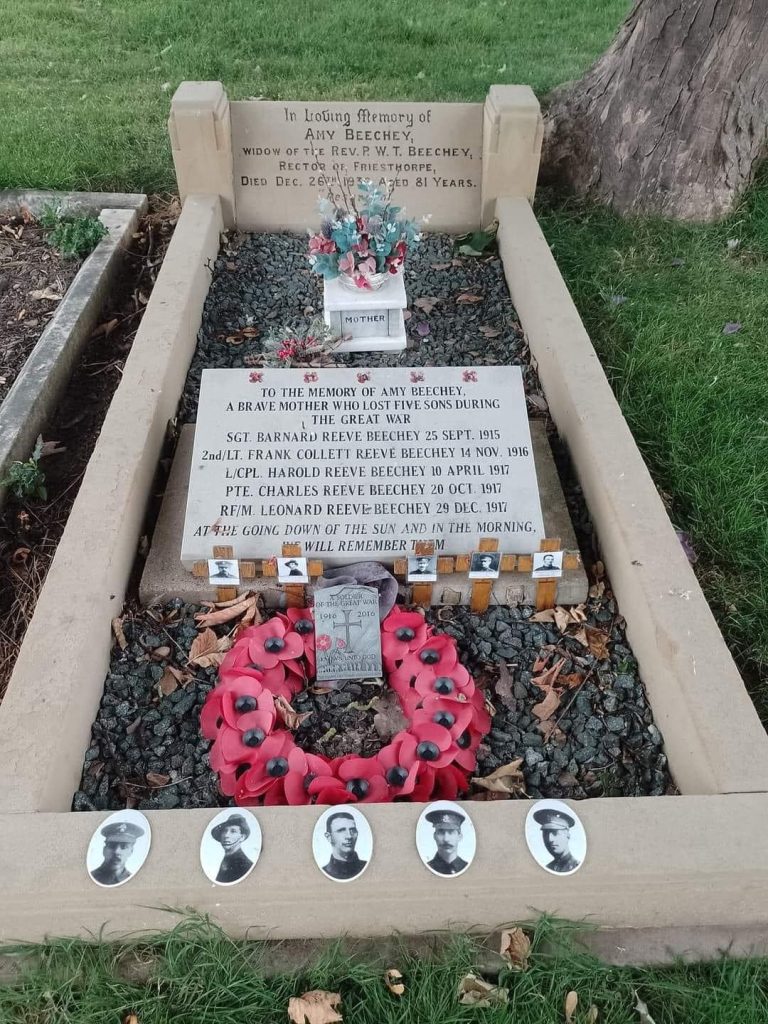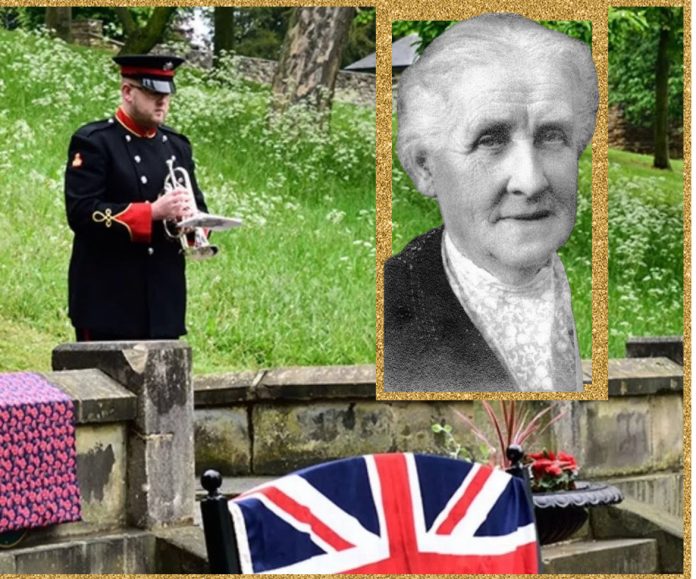Please let me introduce you to Amy Beechey.
The Great War, known today as World War I, brought untold sorrow to countless families across Britain. One such family, the Beecheys of Lincoln, became a symbol of sacrifice and the high cost of war. At the heart of this story is Amy Beechey, a mother who sent eight of her sons to fight for King and Country. Of those eight, five did not return.
Amy Beechey, born in 1859, was the wife of the Reverend Prince William Thomas Beechey, a clergyman in the Church of England. The couple had a large family, raising eight sons and three daughters in the tranquil surroundings of Lincolnshire. The Beechey household was a close-knit and devout one, instilling in their children a strong sense of duty, service, and patriotism.
When war broke out in 1914, the Beechey sons answered the call to arms without hesitation. The eldest, Barnard, was already serving in the Royal Navy, and soon his brothers followed. Before long, eight Beechey boys were in uniform, serving on various fronts across Europe and beyond.
The Beechey sons served with distinction, but the war was merciless. The first blow to the family came in September 1915, when 38-year-old Barnard Beechey, serving with the Royal Fusiliers, was killed in action in the Battle of Loos. His death marked the beginning of an unimaginable ordeal for Amy Beechey.
A few months later, in November 1916, another son, 30-year-old Charles, who was also serving with the Royal Fusiliers, died of wounds sustained during the Somme offensive. Just weeks later, in December 1916, 26-year-old Frank, serving in the Lincolnshire Regiment, was killed in action in France. The Beechey family’s grief deepened in 1917 when Harold, aged 37 and serving with the Royal Field Artillery, succumbed to wounds in Italy.
The final blow came in April 1918, when 31-year-old Leonard, who had served with the Royal Naval Division, was killed during the Battle of Arras. Five sons, all lost within the span of three years, left an indelible scar on Amy Beechey’s heart.
Despite her unimaginable loss, Amy Beechey remained steadfast. In 1918, King George V invited her to Buckingham Palace to personally express his condolences. It is reported that Amy, when presented to the King, humbly remarked, “It was no more than I and many other mothers have done.” Her words epitomised the stoicism and selflessness of so many mothers who had endured similar losses during the war.

The story of Amy Beechey and her sons became widely known after the war, symbolising the profound sacrifices made by families across Britain. In Lincoln, a memorial plaque was unveiled in 1919 at Lincoln Cathedral in honour of the Beechey brothers, an enduring testament to their bravery and the family’s sacrifice.
Amy Beechey’s story is a poignant reminder of the human cost of war. The Beechey family’s loss resonated throughout Britain, representing the grief felt in countless homes during and after the Great War.
Amy Beechey passed away in 1936, her life forever marked by the loss of her sons. Today, her legacy lives on, not only in the memorials dedicated to her boys but in the recognition of the sacrifices made by all families who endured the heartache of war.
The story of Amy Beechey is a testament to the courage, resilience, and quiet dignity of those on the home front during the Great War. Her loss is a reminder of the true cost of conflict, borne not just by those on the battlefield, but by the families who sent their loved ones to fight, never knowing if they would return.
How many died in World War 1?
The total number of deaths as a direct result of World War I is estimated to be around 16 to 20 million people. This figure includes both military personnel and civilians.
- Military Deaths: Approximately 9 to 11 million military personnel died due to combat, disease, and other war-related causes. The combatants came from various nations, with the largest numbers of deaths suffered by countries like Russia, Germany, France, and Austria-Hungary.
- Civilian Deaths: Around 7 million civilians are estimated to have died directly due to the war. These deaths were caused by military actions, bombardments, and the widespread famine and disease that accompanied the conflict.
Additionally, millions more were wounded or suffered long-term health effects due to the war. The Spanish flu pandemic, which spread in the final year of the war and its aftermath, caused additional millions of deaths, though these are not always counted as direct results of the war itself.
How this suffering was exposed as a money making venture after the war ended
A leading Major General became a whistleblower and revealed why Amy Beechey’s sons and all the other millions died during the so called ‘Great War’.
‘War is a racket. It always has been. It is possibly the oldest, easily the most profitable, surely the most vicious.‘ – Major General Smedley D. Butler
Major General Smedley D. Butler’s famous 1935 pamphlet, War Is A Racket, offers a scathing critique of the American war machine, particularly the profiteering that surrounded World War I. Butler, a highly decorated Marine who served in various conflicts, saw firsthand how war was used as a means for profit by a small group of wealthy individuals and corporations, while the majority of the population paid the price. His insights remain relevant today as they expose the dark underbelly of military conflict: the pursuit of profit.
The Profiteers of World War I
World War I, often referred to as “The Great War,” was a massive conflict that engulfed much of the world between 1914 and 1918. While millions of soldiers and civilians suffered and died, certain American businesses and individuals reaped vast financial rewards. Butler identified several key sectors that profited immensely from the war, highlighting the immense disparity between the fortunes of the rich and the sacrifices of the common people.
1. Munitions Manufacturers
Perhaps the most notorious profiteers were the munitions manufacturers. Companies like DuPont, which had a near-monopoly on explosives, saw their profits skyrocket during the war. DuPont’s earnings increased by over 950% during the conflict. Before the war, DuPont’s profits averaged $6 million annually; by 1918, they had reached $58 million. The company supplied a vast amount of the explosives and munitions used by the Allies, making a fortune as the war dragged on.
Similarly, other arms manufacturers such as Remington and Bethlehem Steel saw enormous gains. Remington, which produced rifles and ammunition, experienced a surge in demand. Bethlehem Steel, which supplied steel for ships, armor, and guns, also thrived. These companies made millions, with little regard for the human cost of the products they were selling.
2. Shipbuilders
The shipbuilding industry was another significant beneficiary of World War I. With the United States entering the war in 1917, the demand for ships to transport troops and supplies to Europe grew exponentially. Companies like Bethlehem Shipbuilding Corporation and Fore River Shipyard (owned by Bethlehem Steel) received massive contracts from the U.S. government.
These contracts were often awarded on a “cost-plus” basis, meaning the companies were guaranteed a profit regardless of how much they spent. This arrangement incentivized inefficiency and waste, as the more a company spent, the more it could charge the government. The profits were staggering; Bethlehem Steel, for instance, saw its profits rise from $6 million in 1914 to $49 million in 1918.
3. Bankers and Financiers
While the industrialists were reaping the benefits of government contracts, bankers and financiers were also profiting from the war. J.P. Morgan & Co., one of the most powerful financial institutions in the world, played a crucial role in financing the Allies, particularly Britain and France. The firm arranged loans totaling over $3 billion to the Allied powers, with significant interest rates ensuring hefty profits for the bankers.
Morgan also facilitated the sale of American goods to the Allies, acting as a purchasing agent for Britain and France. The firm made millions in commissions while ensuring that American industries remained fully employed. The war thus became a boon for Wall Street, which thrived on the debt and destruction created by the conflict.
4. The Chemical Industry
The chemical industry, which included companies like DuPont and Hercules Powder, also profited significantly from the war. Beyond munitions, these companies produced a range of war-related chemicals, including poison gas. The use of chemical weapons, though horrific, became a new and profitable frontier for these companies.
DuPont, already mentioned for its explosives, expanded its operations into other chemical products during the war. The company’s dominance in the chemical sector during the war years laid the groundwork for its post-war expansion into other markets, solidifying its status as a major industrial power.
While these companies and individuals amassed fortunes, the true cost of the war was borne by the millions of soldiers and civilians who suffered and died. Over 116,000 American soldiers lost their lives in World War I, and countless more were wounded, physically and mentally scarred by the horrors they endured. For the vast majority, there was no financial gain—only sacrifice.
Butler’s central thesis in War Is A Racket is that war is not fought for democracy or freedom, but for profit. The vast sums of money made by a select few during World War I underscore this point. The war was a lucrative business venture for those who stood to benefit, while the rest of the world paid with blood and tears.
World War I was a stark example of how a small group of individuals and corporations can profit immensely from conflict. Smedley Butler’s War Is A Racket serves as a powerful reminder that behind the patriotic rhetoric of war often lies a more cynical truth. The profiteers of World War I exemplify the dangers of a system where war becomes a business, and human lives are simply another cost of doing that business. As long as war remains profitable, Butler warns, the world will continue to be plagued by conflict.
If Amy and her sons and all of the other sons… had known the role they were playing would they have still chosen to play this role? Some possibly but the vast majority would hopefully have told the narcissistic politicians and corporations where they could stick it. Not only then but also now.
KEEP US ALIVE and join us in helping to bring reality and decency back by SUBSCRIBING to our Youtube channel: https://www.youtube.com/channel/UCQ1Ll1ylCg8U19AhNl-NoTg AND SUPPORTING US where you can: Award Winning Independent Citizen Media Needs Your Help. PLEASE SUPPORT US FOR JUST £2 A MONTH https://dorseteye.com/donate/







